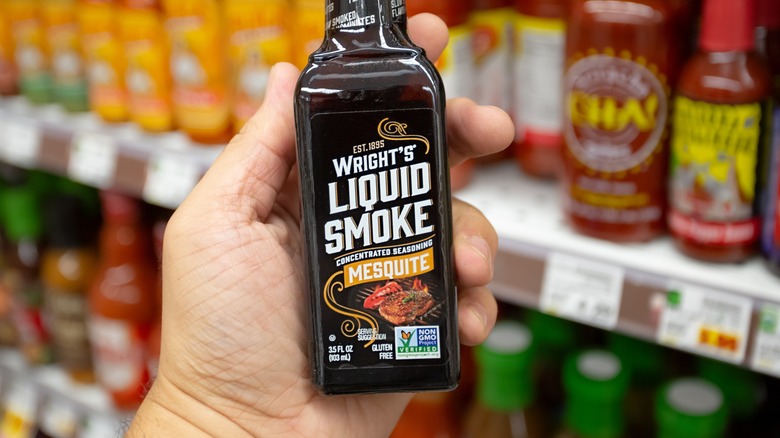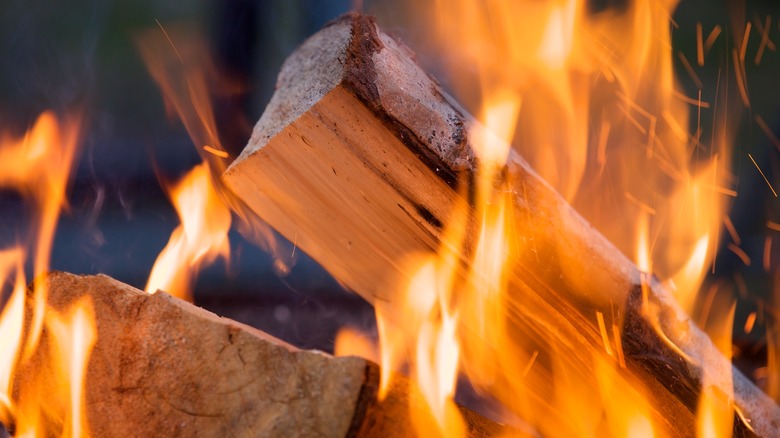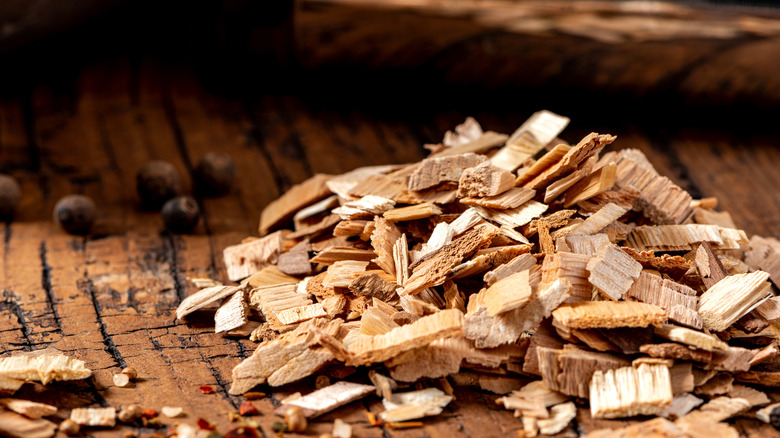We Finally Know How Liquid Smoke Is Actually Made
If you've never tried it, liquid smoke is exactly what it sounds like — smoky flavor that you'd expect to find in food cooked over a grill, smoker, or campfire captured in a bottle where it can easily be sprinkled or poured into everything from stews to chilis to cocktails. For smoky flavor fans, it's a pantry must-have. Liquid smoke has its fair amount of skeptics and haters though. While some say they simply can't stomach the flavor, most of the problems seem to stem from the overuse of liquid smoke: the strong flavor can easily overwhelm a dish. There are also those who douse meats in way too much liquid smoke as a sneaky shortcut so they can skip the time-intensive smoking process. That's something diehard smoking and grilling fans just can't abide.
When used as it should be — in moderation, a few drops at a time — liquid smoke really is an easy way to amp up the flavor in recipes, especially when there's no fire to otherwise get that delectable smokiness. And best of all, it's not just some artificial ingredient with questionable origins. Liquid smoke comes from — you guessed it — smoke! Here's how it's made.
Liquid smoke has a 138-year history
The making of liquid smoke begins with wood and fire. The same types of distinctive woods that are favored by pitmasters for the flavors they impart — hickory, apple, mesquite — are also used to create this unique ingredient. Wood chips are burned, and as they burn the rising smoke passes through condensers that extract the water from the plumes. The water collected in the condensers is infused with a smoky flavor. It's then heated and reduced, which concentrates the wood smoke flavor until it's very strong and very potent. Liquid smoke is then packaged in bottles for sale.
The process to create liquid smoke was perfected way back in 1895 by a Missouri pharmacist named Ernest H. Wright. As a teen, he observed that as smoke rose from a woodstove pipe, water would trickle back down the pipe — and that water tasted like smoke. He carried that memory into his scientific studies as an adult and discovered that water droplets form when hot wood smoke meets cold air. He invented the method of sending the smoke through a condenser to capture the water, and created the first liquid smoke product that's still on store shelves today: Wright's Liquid Smoke.
His creation was first promoted as a way to preserve raw meats, and eventually as a flavoring. Wright's liquid smoke soon had many copycats who puzzled out his process to create their own versions.
The best liquid smoke has only two ingredients
Back when it was invented and still today, Wright's product contains only two ingredients: water and wood smoke. Unfortunately, not all of the brands today maintain that purity. It's not uncommon to find bottled liquid smoke that contains a much lengthier and more complicated list of ingredients like soy sauce, seasonings, vinegar, molasses or other sugars, salt, preservatives, and artificial coloring to give it a deep shade of brown.
This kind of doctoring, plus variation in flavor between liquid smoke brands, is no doubt a big contributor to the wide range of opinions about the effect liquid smoke has on food. What should be the simple addition of a little smoky flavor may unintentionally add salt, sweetness, and other unexpected flavors to the dish.
For the best possible liquid smoke experience, check the labels and choose only those that contain just water and wood smoke. Some brands offer different flavors based on the type of wood used in the process. Also, use liquid smoke sparingly in dishes, especially when it's your first time giving it a try. The flavor is very concentrated and a little truly goes a long way. Considering that you'll only use a little at a time, and that liquid smoke has a ridiculously long shelf life (as much as 48 months) it's an all-natural ingredient well worth adding to your pantry.


